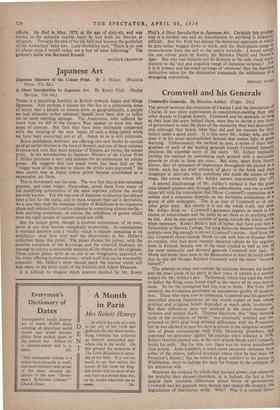A Short Introduction to Japanese Art. By Romy Fink. (Seeley
Service. 12s. 6d.) THERE is a persisting hostility in Britain towards Japan and things Japanese. And perhaps a reason for this lies in a continuing sense of shock that a people so remote from us geographically, a people we had distantly rather admired, should have been able to inflict on us such startling damage. The Americans, who suffered far more than we did in the Eastern War, appear to have lost their sense of distrust. But then they have been intimately concerned with the shaping of the new Japan (if such a thing exists) while we have been concerned not at all. Japan to us is still unknown.
Brave publishers, however, are offering two new books to remind us of an earlier interest in the land of flowers, and one of these volumes is concerned with that most popular of Eastern art forms, the colour print. In his introduction to Japanese Masters of the Colour Print J. Hillier produces a very odd defence for an enthusiasm for colour prints. He suggests that too much stress has been laid on the "vulgar taste of the people to whom the prints were purveyed." He then claims that in Japan colour prints became established as a respectable art form.
This is fortunately not the case. The very fact that prints remained popular, and even vulgar, illustration, saved them from many of the stultifying conventions of the most ingrown culture the world has ever known. For the tap-root of Japanese civilisation has always been a lust for the static, and in most respects their art is derivative. As a race they took the immense vitality of Buddhism in its expansive phase and reduced that creative impulse to something almost sterile-- with startling exceptions, of course, the rebellions of genius which even the rigid canons of custom could not stifle.
But the colour print, though it evolved conventions of its own, never at any time became completely respectable. In consequence it retained emotion and a vitality which is sharply appealing in its simplicity. And how very well the illustrations in Mr. Hillier's collection make this point. The plates chosen for colour, with the possible exception of the Kiyonaga and the waterfall Hokusai, do manage to convey a reasonable measure of the charm of the originals. These colour plates serve as an aid to an imaginative approach to the wider offering in monochrome; which is all that can be reasonably expected. Mr. Hillier's work should spark the interest which will lead many to the print room of the Victoria and Albert Museum.
It is difficult to imagine much interest sparked by Mr. Romy Fink's A Short Introduction to Japanese Art. Certainly this probe" tion is a modest one and an introduction to anything is hideously difficult. But Mr. Fink has chosen the historical approach in which he gets rather bogged down in myth, and the illustrations range In monochrome from the dull to the nearly invisible. I would except the one colour plate by Korin, the Shotoku Daishi and Noarre s tiger. But why one lumpish pot by Kenzan as the sole visual intro- duction to the vast and exquisite range of Japanese ceramics? For it is in pottery and the small carvings of ' °kimono' that the Japanese instinctive talent for the diminutive transcends the inhibitions of a strangling convention. OSWALD WV°


































 Previous page
Previous page